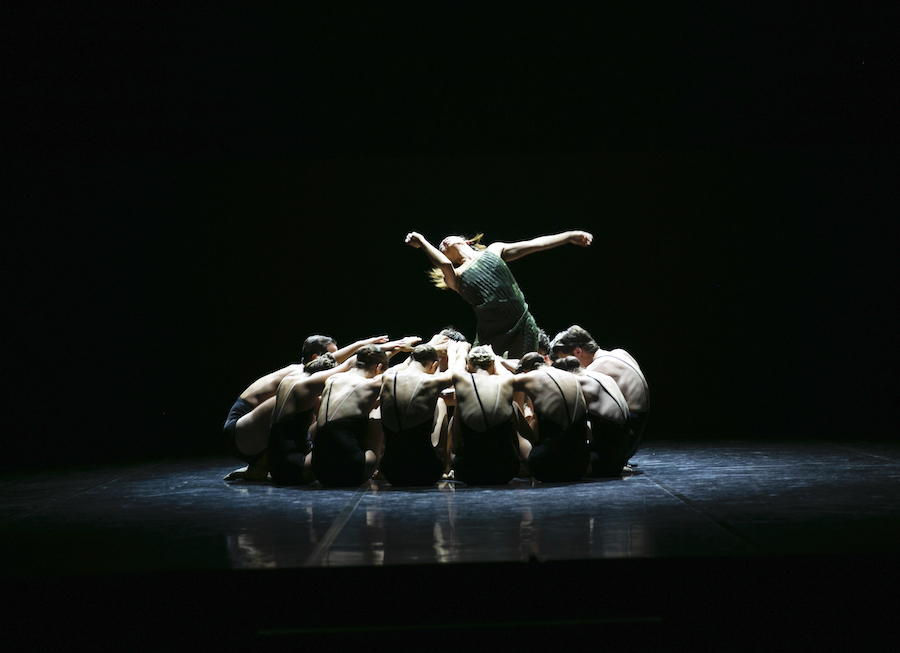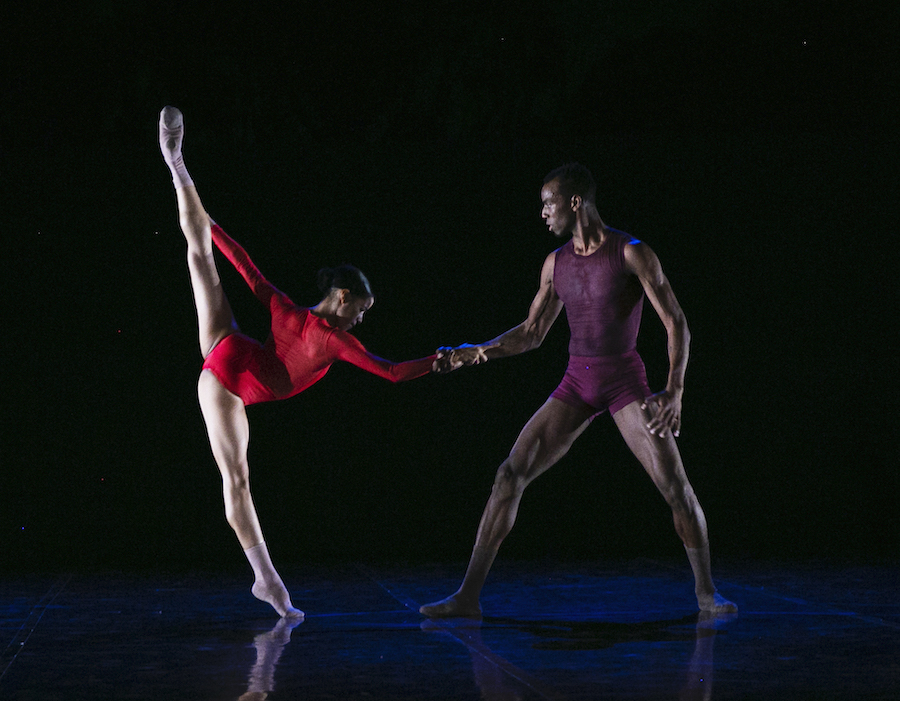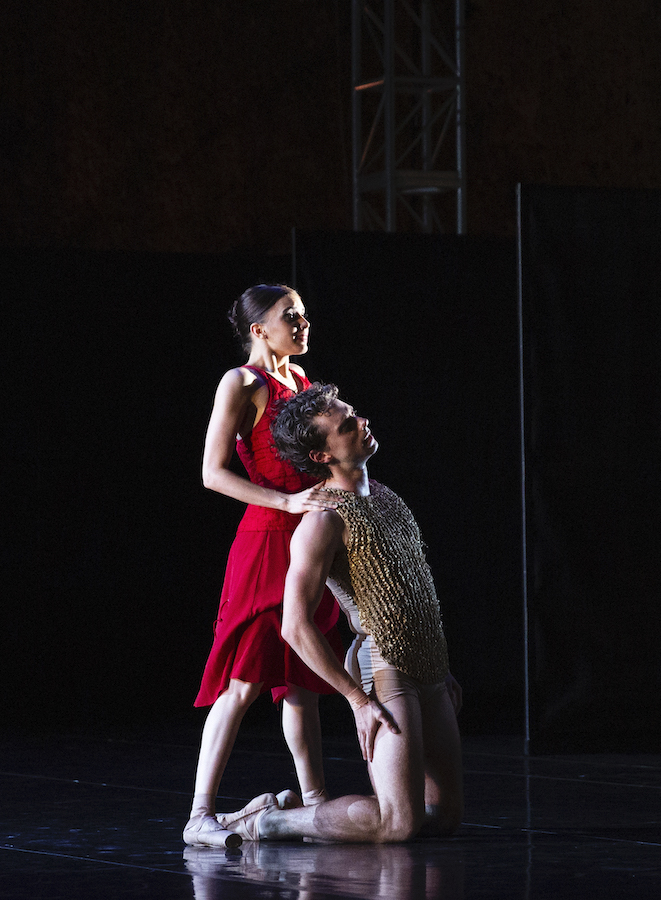An interesting aspect of The West Australian Ballet’s production is that although the three pieces which make up Light and Shadow reflect on the poignant interaction of male and female, the excerpt from Graeme Murphy’s Air and Other Invisible Forces seems marked by that inescapable influence of this land, with its myths and mystery, that eventually permeate the souls of those of us who have lived here for any length of time. Its production in the pockmarked stone shell of the historical Quarry no doubt aided this perception.
Adding manna to Murphy’s captivating choreography was his choice of music, Mourned by the Wind. Its composer, Giya Kancheli, hailing from Georgia, where inhabitants have long fought for its culture and land against invaders, was wonderfully empathetic in its lyricism and turbulent interchange of viola and orchestra.
 Chihiro Nomura and the dancers of West Australian Ballet in Air and Other Invisible Forces. Photo © Sergey Pevnev
Chihiro Nomura and the dancers of West Australian Ballet in Air and Other Invisible Forces. Photo © Sergey Pevnev
Murphy’s choreography focuses on a quintessence of emotion through small, individual dramas, while a lone black-clad dancer (Glenda Garcia Gomez) wanders on stage at intervals as though searching for something or someone. It is marked by a motif of encircled bodies. This group, dressed by Akira Isogawa in slivers of green, sways like rushes in a gentle wind. Out of the centre of this human vortex emerges a lone body to ascend and descend upon the backs of the others, who eventually pair up in a whirlwind of duets. Intermittently, the stylish trio of Matthew Lehmann, Julio Blanes and Garcia Gomez perform, with lucid clarity, a series of ingeniously conceived interaction. The company grew sharper as the piece progressed.
Wubkje Kuindersma is a young, up-and-coming choreographer. She has created Architecture of Hope on the West Australian Ballet as a co-production with Dutch National Opera and Ballet. It’s set to movements 1-4 of Ezio Bosso’s Symphony No 1 “Oceans”, which Kuindersma says made her think that hope arrives in waves, just like the ocean itself.
 Juan Carlos Osma and Dayana Hardy Acuña in Architecture of Hope. Photo © Sergey Pevnev
Juan Carlos Osma and Dayana Hardy Acuña in Architecture of Hope. Photo © Sergey Pevnev
Carina Roberts, Jesse Homes, Dayana Hardy Acuña, Juan Carlos Osma, Claire Voss, Matej Perunicic, Polly Hilton and Ludovico Di Ubaldo participate in a series of duets which rupture into energy and space or render tender expressions of love and interplays of emotions. Kuindersma gives a linear clarity of structure to this work while affording her dancers, dressed in bright red, the ability to convey an engaging distinction of style – rather like the edges of diffident waves combing the shore. At times, candles are raised on high as though in supplication to the moon’s control of the ebb and flow of both tidal and human emotions. The dancers were exquisitely expressive.
Krzysztof Pastor, who thrilled Perth audiences with the gutsy and bloodthirsty Dracula in 2018, showed another side of his choreographic prowess in the more genial In Light and Shadow, set to Johann Sebastian Bach’s Aria from the Goldberg Variations and the Orchestral Suite No 3 in D Major. The dancers were dressed by Yuh Egami in a variety of eclectic clothing which included a metallic skirt worn by Chihiro Nomura spreading out curtsy-like or covering her when dancing with the powerfully lithe Carlos Osma, in their ravishing duets. Nomura is as graceful as the wings of a hovering dragonfly, while Carina Roberts in this and all her roles was utterly magnetic; so too, the impeccable Hardy Acuña.
 Carina Roberts and Oliver Edwardson in In Light and Shadow. Photo © Sergey Pevnev
Carina Roberts and Oliver Edwardson in In Light and Shadow. Photo © Sergey Pevnev
A first, accompanied by the piano, with its composition of rather bruised sweetness, eight dancers performed various duets filled with luminous emotion. Then suddenly, as the Orchestral Suite took flight, the whole company plunged themselves into a tornado of movement. Influences seemed drawn from the long-lined parallel dances associated with the Georgian era, or folk dances, or the cultural dances of various religious sects (such as the Shakers.) In keeping with village festivities, the men at times danced together ritualistically with a bravura made to capture the attention of their desired, whilst the women danced mainly for themselves, once in an outstanding sequence in which side-lighting spotlighted their lower legs moving rapidly in a floodtide of clever footwork.
The company, whose engaging qualities emanate from their sparkling and insouciant understanding of their hard-won prowess, was resplendent in this stylish, contemporary production at the Quarry and Aurelien Scannella is to be particularly lauded for restaging a work by our own éminence grise, Graeme Murphy – whose works will ever continue to enthrall.
Ballet at the Quarry: Light and Shadow continues at the Quarry Amphitheatre as part of Perth Festival until February 29











Comments
Log in to join the conversation.